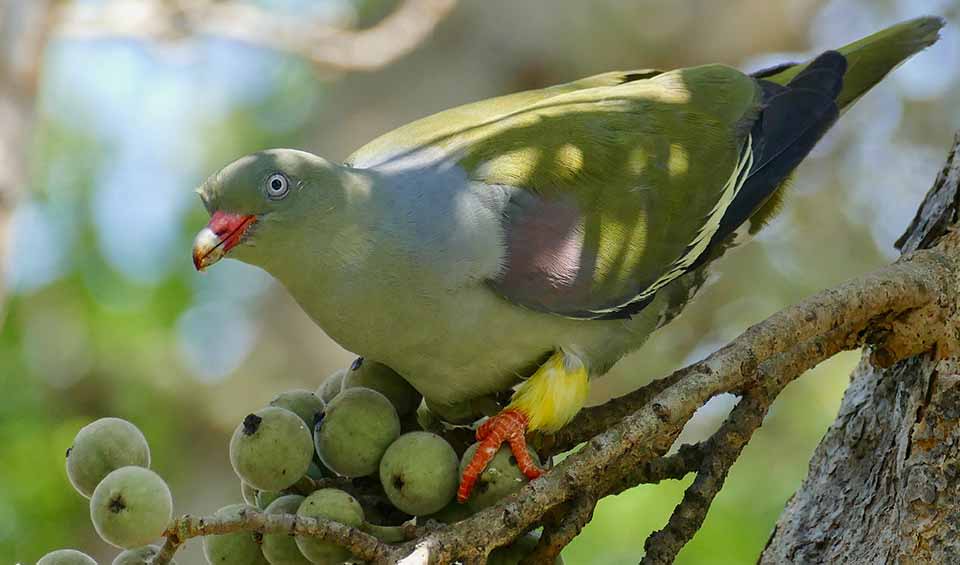A beautifully camouflaged and surprisingly agile bird that brings a splash of subtle color and quiet charm to forests, woodlands, and even city parks across sub-Saharan Africa. Though it may not be as flamboyant as tropical parrots, this pigeon is a master of blending in with its leafy surroundings, thanks to its soft green plumage, gentle movements, and tree-loving habits.
The African green pigeon has a stocky body, a short neck, and a small head, typical of many pigeon species. Its plumage is mainly olive green, which allows it to disappear into foliage with ease. The shoulders and wings are marked with maroon and yellow, adding a splash of color when the bird is in flight or seen up close. The bill is reddish with a pale tip, and the eyes are bright, giving the bird a gentle but alert expression.
This pigeon is arboreal, meaning it spends most of its time in trees, rarely coming down to the ground. It is highly skilled at clambering among branches, much like a parrot—using its strong feet and claws to move nimbly while feeding. It prefers areas with fruiting trees, such as figs and wild plums, and is especially fond of fermenting fruit, which has led to occasional reports of them becoming a little “tipsy” after indulging.
African green pigeons are social birds, often found in small flocks or family groups. When feeding, they move quietly through the canopy, often going unnoticed despite their size. They are generally silent or soft-voiced, but they do produce low, growling coos or croaky whistles, especially when disturbed or during mating displays.
Distribution
 Angola
Angola Benin
Benin Botswana
Botswana Burkina Faso
Burkina Faso Burundi
Burundi Cameroon
Cameroon Central Af. Rep.
Central Af. Rep. Chad
Chad Congo-Brazzaville
Congo-Brazzaville Côte D’ivoire
Côte D’ivoire DR Congo (Kinshasa)
DR Congo (Kinshasa) Equatorial Guinea
Equatorial Guinea Ethiopia
Ethiopia Gabon
Gabon Gambia
Gambia Ghana
Ghana Guinea-Bissau
Guinea-Bissau Guinea
Guinea Kenya
Kenya Liberia
Liberia Malawi
Malawi Mali
Mali Mauritania
Mauritania Mozambique
Mozambique Namibia
Namibia Niger
Niger Nigeria
Nigeria Rwanda
Rwanda Senegal
Senegal Sierra Leone
Sierra Leone South Sudan
South Sudan Sudan
Sudan São Tomé & Príncipe
São Tomé & Príncipe Tanzania
Tanzania Togo
Togo Uganda
Uganda Zambia
Zambia Zimbabwe
ZimbabweAnything we've missed?
Help us improve this page by suggesting edits. Glory never dies!
Suggest an editGet to know me
Terrestrial / Aquatic
Altricial / Precocial
Polygamous / Monogamous
Dimorphic (size) / Monomorphic
Active: Diurnal / Nocturnal
Social behavior: Solitary / Pack / Herd
Diet: Carnivore / Frugivore / Omnivore / Piscivorous / Insectivore
Migratory: Yes / No
Domesticated: Yes / No
Dangerous: Yes / No




